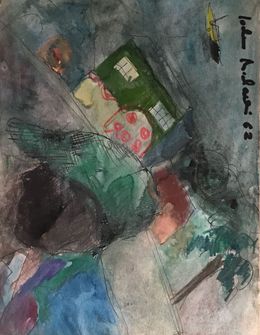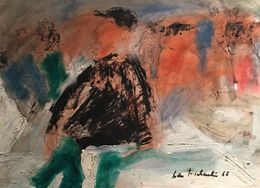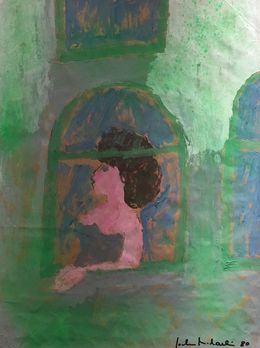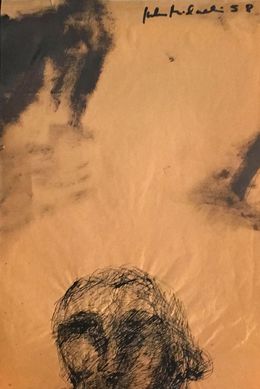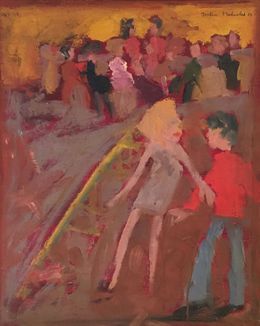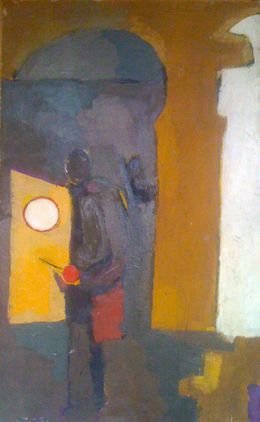Portraits of Parisians, by Jochen Michaelis. "Lise Cormery's gallery in Paris exhibits nineteen 'Portraits of Parisians' by Michaelis which range from her first flagship exhibition from 1958 to 1981. Her first exhibition in 1958 in Paris had aroused favorable and rave reviews from the press and from the Parisian Art Critic who praised the quality of his painting, his work was so powerful and the artist disarming.He was however the grandson of a German chancellor, which was not favorable in these troubled times of 'Post-War, in a Paris still scarred by the conflict. In 1958, “ARTS” said of Michaelis that he was “fascinated by the isolation of beings in crowds.”
“Le Monde” underlines that his “ humor does not lose its rights. ”The newspaper“ Combat ”, with prestigious signatures, Camus, Aron, Gide, photographs him in the middle of his paintings on the ground including“ La Parisienne aux faux cils ”and thus qualifies the spirit of his work "A dream sometimes bitter, sometimes caricature and full of tender sse. "For" Hors-Côte "," Michaelis observes humanity with a sharp eye, the world where we have fun. " The 1958 portrait, "La Parisienne aux faux cils", photographed as Michaelis throne in the middle of her paintings, is one where, according to the newspaper "Combat", Michaelis uses "all the resources of Bonnard's poster. or Lautrec, he brings out in the foreground ambiguous faces drowned in immense earthy spaces ”. It is the same for "The Spy", with the shaggy head lost in a large brownish space, undoubtedly a self-portrait of the artist, who observes and spies, and as adds the art critic of "Combat", is “a painting of manners and society, even if the world is ridiculous…”.
As for “The Bus in Paris”, it prefigures Street Art nowadays, painted, as Toulouse-Lautrec did on poor supports, just like the magnificent and large enigmatic portrait of Michaelis between abstraction and figuration, “Parent Enfant” , painted in 1959 on a primitive canvas mounted on a makeshift rough wood which gives it a nostalgic and almost mythical aspect. His series of paintings from the 60s is always incisive, with his paintings of Parisian women always subtle and somewhat caricatural, he sketches the coquettes, the socialites. “Les confidences des Parisiennes” from 1962 is mobile, as on a magnificent green background an exquisite silhouette seen from the back sways, and where luscious red kissed mouths, in the foreground, invite us to confidences in the hollow of the ear, to the power games of the elegant, but that we can guess so bitchy. As for the “Chanteuse de l'Opéra de Paris” and “La Pianiste de l'Opéra de Paris”, their composition of 1964 invites us to the momentum of music. For his 1963 work "The kiss" or "The lovers of the Eiffel Tower, in the night", his treatment is unique and the title is a clue so that the eye of the art lover can understand what is happening. play in this painting.
With “The Man in the Green Cap” painted in 1966, his innovative composition prefigures the living art of the 21st century, it also requires a double gaze to capture this portrait, treated as an abstraction. The same goes for “The Man in the Black Cape in the Crowd” of 1966. As for “The Concierge at Her Window” of 1966, Michaelis, not without humor, refers us to those harpies who were spying on everyone in the room. the popular Parisian buildings, the queens of gossip of the time, no one could escape their caudine forks and beware of those who could not pay their rent. His portrait of a young couple in “Paris Dancing” of 1967 is an oil on canvas almost naive, while respecting his style and “La promenade, Walking” of 1968, remains in the spirit of his series “Paris Orange”, “Paris Nuit”, “Paris blanc”. But they contrast resolutely with “The Nun” painted in 1969. A somewhat incongruous painting today of these passers-by with the silhouette however familiar at the time of these nuns in uniform who could be seen walking freely in the streets of Paris in the sixties. , but who is no longer. In a country now resolutely ideologically anticlerical, priests and nuns, for fear of disapproving looks, must blend in with the mass of very expensive and energy-consuming uniform denim overalls from “Big Brother”.
In the 70s Michaelis continued his observation and his portraits of Parisians, there was still an even more radical change in clothing habits with colorful groups very contemporary with today's Street Art, "Foule à Paris et sa Banlieue" by 1975, or “Parisians on a green background”, from 1978, painted on green paper which serves as both a support and a background. But nevertheless he still wants to paint his pretty Parisiennes, these "Madame Tout le Monde" who were admired by yesteryear, and who nevertheless, timidly, still compete in elegance, even for lack of means and it is in 1974 " Parisienne à la toque ”, 1980“ Parisienne at the window ”, 1981“ The elegant at the market ”, even if the end soon begins, and the dictatorship of uniform political correctness which is costly to the poor who nevertheless drink it. by enriching multinationals in the name of "The brand", a new ephemeral societal dictatorship of the moment.
Lise Cormery - "The art of the Paris School of Post-War" Editions Michelangelo, Paris
BIOGRAPHY Jochen MICHAELIS
Jochen Michaelis, a fine observer of the theater of life in Paris
Jochen Michaelis was born in Postdam, Germany in 1938. Lise Cormery in her book "The art of the Post-War Ecole de Paris" writes his biography. "Michaelis born in Germany in 1938 studied and settled many years in Paris and thus belongs to the German Post-War Ecole de Paris. Indeed, in the fifties, Germany is still deeply injured, art schools are destroyed, the country divided into East and West with the Berlin wall and artists have to find a shelter in order to create in peace, far away from political turmoil.
He is the grandson of Georg Michaelis (1857-1936), Minister President of Prussia and in 1917 German imperial Chancellor of Germany, heading the administration of Pomerania from 1918 to 1919. Jochen Michaelis studies at Kassel KunstAkademie, Germany. In Paris Beaux-Arts he studies painting with Chapelain Midy and lithography with Clarin. He will perfect his knowledge of art printing in Pratt Graphis Center of New York later on.
Michaelis travels and exhibits his paintings of a keen and poetic observer of people in their daily life in Paris, New York, Berlin and also during a trip in Mexico.
In Paris his artistic career is launched very fast and he becomes famous very young, exhibited in many art galleries in Paris. In 1958, he is only twenty years old and all the Press and Art critics are acclaiming his paintings and soon he belongs to all the important collections of contemporary art.
For art critic and art magazine "ARTS", "Michaelis is painting scenes of daily life like did Bonnard or Lautrec, with ambiguous faces lost in vast spaces. He is fascinated by the loneliness of people lost in moving crowds." For "Le Monde", "Michaelis creates large and very personal compositions full of energy where humor is not forgotten." "Combat", a left-wing newspaper, the most powerful Post-War media making or breaking artistic careers, with signatures of famous writers like Albert Camus, Raymond Aron, André Gide, writes an important article devoted to Michaelis with a photo of the artist sitting in the middle of dozens of paintings on the ground, one can recognize on the lower right "The Parisian with false eyelashes" painted in his expressionist manner. The "Combat" art critic writes a long text on Michaelis, "His painting is a dream sometimes bitter, full of tenderness, sometimes with a sense of humor, rhythm and violence. He is a painter of a Parisian way of life, recreating scenes of daily life" like Daumier did."
"Michaelis in his "Paris Orange" and "White Paris" is painting The Humble against the Arrogant. With his series of paintings "Night in Paris", the crowds in quest of pleasure and dressed for the occasion and his series of "Parisians" are devoted to portraits of typical inhabitants of the city.
When in 1958 Michaelis is starting painting Paris in "Orange", it is still a rare color, very seldom used in the past. A long time after him, in the 70's it will become very fashionable and Orange will become the Must Color for designers, and everything will be declined with Orange in fashion, design, advertising.
Paris, during the 60's and 70's is a paradox where two different worlds are confronted, the humble Paris of old stones attached to Paris City of Light of yesteryear against the presumptuous Paris, in love with concrete and "progress".
Michaelis is painting in 1968 "Paris Détruit, Géraniums et pelleteuse Orange" "Destroying Paris, Orange Geraniums and Orange Excavator", depicting the forgotten world of the humble, victim of the Bouygues "Orange excavator" destroying modest or historical homes in Montparnasse and Latin Quarter district. Although hope remains in heart, some keep flourishing their humble windows with "Orange geraniums", as an act of resistance, giving a touch of light to forgotten shelters that desperate Parisians don't want to leave for suburbs lost in nowhere.
While the humble remains frightened, petrified by the destruction of Paris, the arrogant Paris with the paintings "Cocktail Party" and "Maître d'hôtel" in chic restaurants and night-clubs, tearing away cultural Paris with recklessness, enjoys life. Paris is vibrating with joy, life is still cheap and some well-off students "Daddy's boy" are "provoking" the world, everything is permitted for these rich petty-bourgeois dilettantes, honking like grownups. They want the world to believe they are making a "Revolution", although "68" is nothing but a chaos created by spoilt and greedy kids. These ambitious petty-bourgeois want the arrogation of media and political power and indeed they will get it and it is still within their arrogant hands.
Michaelis, observe the birth of a new Paris, between hope and despair. Two worlds are still fighting. Old stones of yesteryear Paris, where sculptor Pablo Gargallo in his modest Montparnasse studio harbored the newcomer Picasso, where they were fed by the fresh eggs of the hen running happily in his tiny garden, so far away from the ugly invasion of concrete. Montparnasse is brutally destroyed. Instead of the romantic Paris, Bouygues concrete and ugliness is invading the city with highways along the Seine River and gigantic towers in La Defense, so arrogant, and like the Twin Towers, they are believing they are just indestructible. And beyond Michaelis times observing Paris, nowadays the massacre of many preserved blocks of 14th arrondissement continues with the closing of hospitals while Covid is killing.
In his "White Paris, foggy pale dawn From Paris City of Light to Dusty Paris" the painter plays on the melancholy of Paris, with its pale mornings, its bistros misted up by alcohol, when a thin fog is creeping up from the Seine River, and Paris is suddenly wrapped into a fluffy pale veil. At dawn Michaelis observes two crowds, two worlds crossing each other but ignoring one another, the wandering night-owls with their hangovers, nicknamed "Fêt'Arts" or "Couche Tard" just out from nightclubs rushing into bistros that have just opened to take a last coffee or a nightcap, meanwhile the invisible workers are rushing out of subways, sweepers as well as construction workers are already starting their long day's work.
Starting in 1958, many Paris and New York art galleries showed Michaelis paintings and sold them to private collectors, where they still belong. Thanks to their recovery we can discover the spirit prevailing in this lost Paris, a poetic world between abstract and figurative painting, with elegant ladies, typical open-air markets and picturesque characters meeting in bistros, playing dice in the early morning or sharing a "café crème. A lost beloved Michaelis dreamlike Paris."
INTERNATIONAL COLLECTIONS His paintings sold by art galleries are still in private hands in Paris, New York and in Germany.
Some International SOLO SHOWS International SOLO SHOWS
1958 Galerie de la Maison des Beaux-Arts Paris 1959 Galerie Glaser-Cordier, Paris 1962 1963 Galerie d'art J. Montana 124, rue du faubourg Saint Honoré, Paris 1964 1967 Galerie Jacques Casanova, Palais-Royal, Paris 1971 Galerie Fischbacher, 33, rue de Seine, Paris 1979 Galerie Raesfeld, Cologne, Allemagne 1979 Galerie Nonson, Soho, New York 1982 Profile Gallery, New York 1984 Galerie Raspail Rive Gauche, Paris 1985 Profile Gallery, New York 1985 1986 Galerie du Marais, Paris 1986 Galerie Raspail Rive Gauche, Paris 1987 Galerie du Marais, Paris 1988 Galerie Tullagasse 2, Breisach am Rhein, Allemagne 1989 Reece Gallery, New York 1991 1992 Galerie Lise Cormery Olympiades des Arts 1992 Montserrat Gallery, New York 1992 The Emerging Collector Gallery, New York 1992 Galerie Bassler Freiburg, Allemagne 1992 Galerie Tullagasse 2, Breisach am Rhein, Allemagne 1993 Montserrat Gallery, New York 1993 Galerie Lise Cormery 1993 1994 1995 1997 Galerie Museum Egon Von Kameke, Postdam, Allemagne. Lukacs Gallery Toronto & De Silgahi Gallery, Burlington, Canada. Magda Fröhlich Art Dealer in Zurich, London, New-York.
PARIS OLYMPIADS
In 1991 and 1992, under the High Patronage of French President Mitterrand and Jacques Chirac, Mayor of Paris, he was selected to represent Germany during the Art Olympiads organized by Lise Cormery Gallery for the CNOSF, French Olympic Committee. This international event was following the famous 1988 Art Olympiads in Seoul, South Korea, where a monumental sculptures Museum in open air and a Museum of International paintings was created for the world competition, in order to invite and show the art of major international artists of the 20th Century.
INTERNATIONAL ART CRITIC PRESS - PRESSE CRITIQUE D'ART INTERNATIONALE
1958 "Arts" 14.10. 1958, "Le Monde" 17.10.1958, "L'Amateur d'Art" 25.10.1958, "Le Figaro" 10. 1958, "Combat" 27.10.1958, "Masques et Visages" Septembre 1958, "L'information" Octobre 1958. 1962 "Echos des Arts" 10. 1962, "Le Hors-Cote" Mars & Avril, "Combat" Avril. 1963 "Les Arts", "Combat" 8 & 23 mars, "ARTS", "Les Echos", "Pariser Kurier", "Die Welt", "Carnet des Arts". 1964 "Combat", "ARTS". 1967 "Santé Publique". 1968 Couverture Cover "La Légion Violette, Revue de La Légion d'Honneur, des Palmes Académiques Arts et Lettres". 1979 "Manhattan East" New York. 1982 1984 "Art Speak" New York. "ART New York". 1994 "Spiegel", "Der Welt". 1984 "L'amateur d'art" 1986 "L'amateur d'art".
SOME PUBLICATIONS QUELQUES PUBLICATIONS
Gerhard Werner Weber, Solange Lemaire, Gérard Weber, Catherine de Hulewicz, François Pluchart, Cate Miodini, Phyllis Lee, Palmer Poroner, Elvira Kühn, Claude Lesuer, Claude Dorval, Lise Cormery.
Read more





